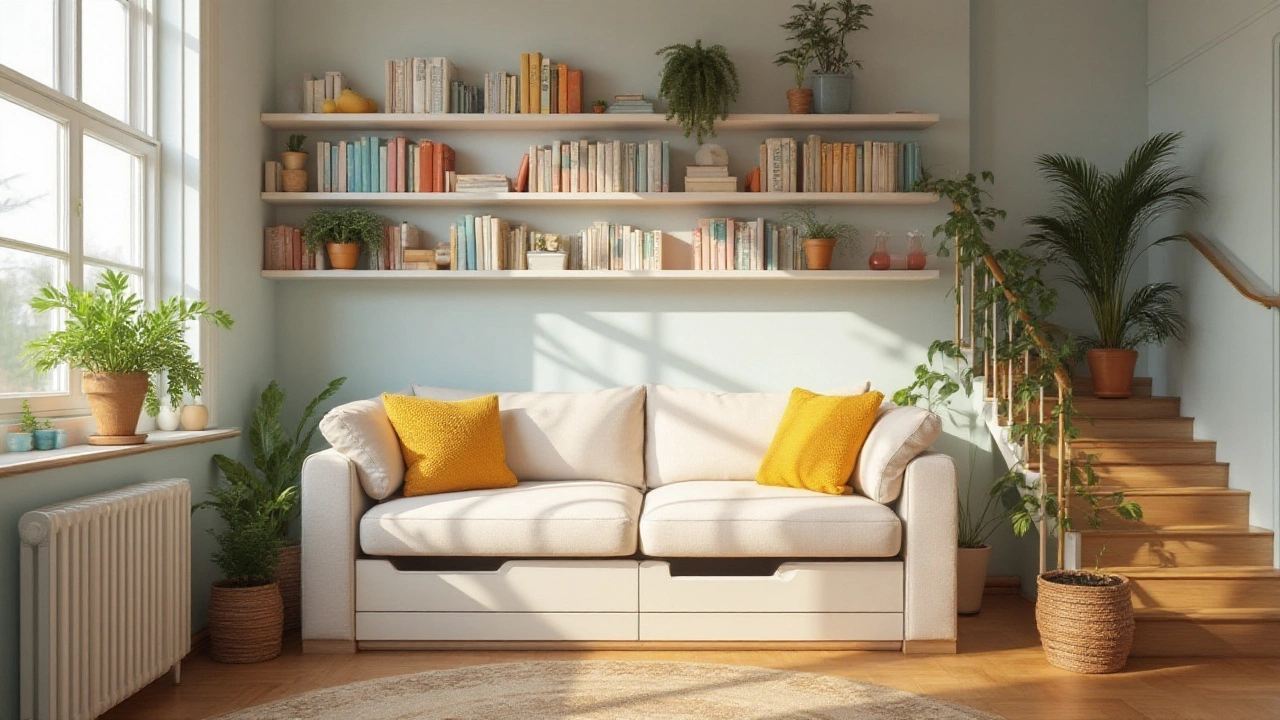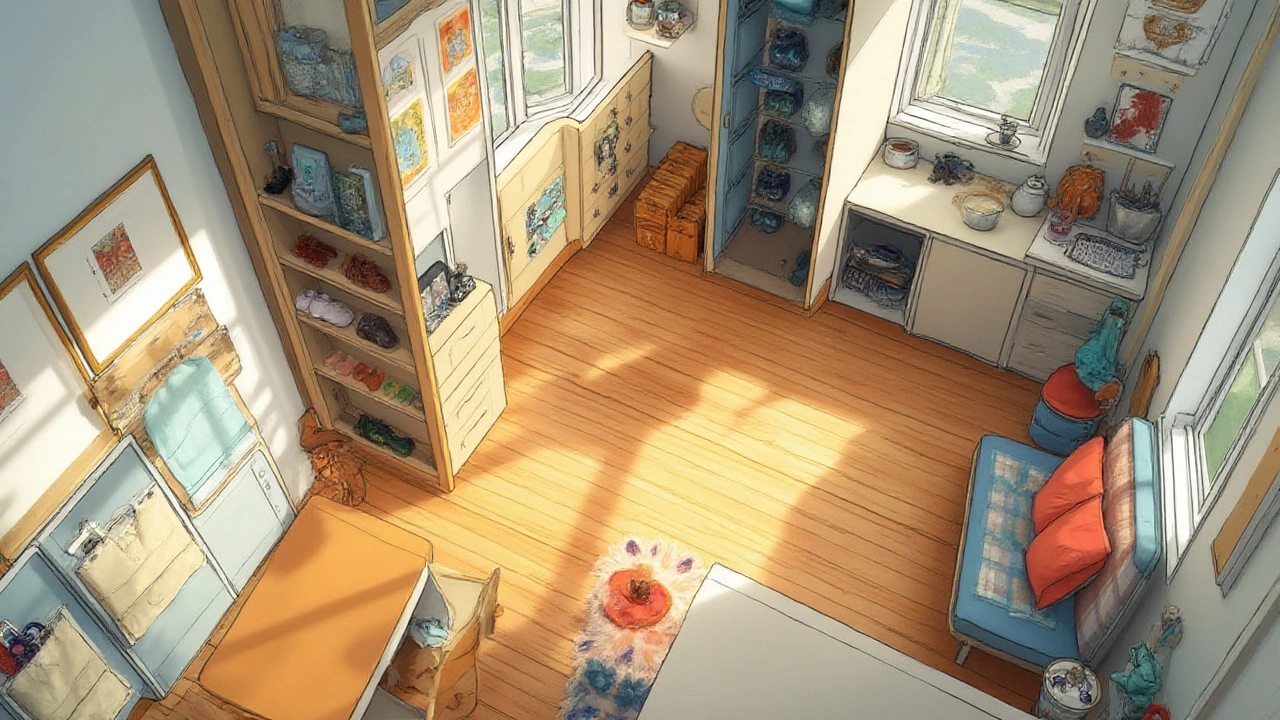Space-Saving Storage Ideas for Small Spaces: Clever Solutions and Expert Tips
 Aug, 2 2025
Aug, 2 2025
Ever tried shoving a winter coat into a closet that’s already packed? Or stacked groceries precariously on your kitchen shelves hoping nothing tumbles out? Living in a small place is like playing Tetris with your stuff—one wrong move, and it’s chaos. What’s wild is that, according to recent stats, the average size of new apartments has dropped by over 100 square feet since 2015. So, if your home feels a bit tighter than you’d like, you’re in good company. But running out of space doesn’t have to mean living in clutter. It’s all about strategy, making the most of every inch, and maybe breaking some old storage habits. Curious about how designers, homeowners, and even tiny house dwellers pull it off? Stick around for smart, honest solutions that actually work.
Clever Ways to Use Vertical Space
Most people underestimate just how much storage they can squeeze out of their walls. The truth is, vertical storage isn’t just for garages or that laundry room shelf you never touch. In cities like Tokyo and New York, where space is as precious as gold, people have turned wall space into their secret weapon. Want real proof? Japanese capsule hotels, which literally fit beds in small stacked pods, use every vertical inch for lockers, cubbies, and fold-down furniture. Here’s the trick: anything you can hang or stack can add storage without eating up floor space. Tall bookshelves don’t have to be for just books—the top shelf is perfect for seasonal items, old photo albums, or those awkward holiday platters.
Shelves above doorways are another overlooked goldmine. In a bathroom, that space over the door is a smart spot for storing extra toilet paper or spare towels. Wall-mounted pegboards are incredibly flexible—you can hang everything from scissors and keys to kitchen utensils on them. IKEA’s SKÅDIS or ELVARLI series, for example, make it easy to hack almost any wall into a modular storage station. And don’t ignore the space above your kitchen cabinets; put decorative bins up there for things you don’t use every day. Even bikes can go on the wall with the right mounts, freeing up precious floor space in the process. If you catch yourself glancing around your place and seeing bare walls, think of them as a blank canvas for storage potential.
Some people shy away from hanging things because of fear of making too many holes, especially if you rent. Good news—removable adhesive hooks, tension rods, and over-the-door organizers have gone mainstream and work surprisingly well. Command hooks, for instance, can hold up to seven pounds, so you can hang coats, bags, or even small shelves without a single nail. Want to get even smarter? Use wall-mounted drop-leaf tables as compact desks or dining surfaces that fold away when you’re done. It leaves your small room uncluttered and open whenever you want. You can even go double duty with art—install open frames or shadow boxes, and stash keys, glasses, or notes inside them. When you stop thinking of your walls as just places for pictures and paint, every inch turns into usable territory.
Maximizing Hidden Storage
You know that feeling when you find money in an old coat pocket? Hidden storage gives you the same buzz, just with your own stuff. The idea is simple: stash your things where no one would think to look—or even where you forget you left them. Start with your furniture. Ottomans with storage compartments, beds with drawers underneath, and sofas that flip open all punch above their weight in tight quarters. Beds with built-in drawers are lifesavers, giving you an entire extra ‘closet’ for shoes, linens, or out-of-season clothes. IKEA’s MALM and BRIMNES beds are famous for this, and there are plenty of budget-friendly alternatives now too.
Think about the spaces you never notice: under the couch (use flat storage bins for books, magazines, or board games), behind doors (older doors can take racks for shoes or cleaning supplies), or even deep cabinets. If you’re short on kitchen drawers, try using a cutlery organizer and stack tools vertically, or mount a pull-down rack under an upper cabinet. Under-sink space is easy to lose track of, but shelf risers and sliding drawers can double what fits.
A popular trick in micro-apartments (think under 350 square feet) is to go full “furniture transformer”—nested tables, Murphy beds, folding chairs, and expandable dining tables are everywhere. Some studio apartments use a single bench with storage for both seating and shoe organization, and it’s all hidden when visitors come over. With kids or pets, getting creative with hidden storage is even more of a game-changer. Built-in window seats offer a cozy reading nook and a spot to hide toys or bedding. The best part? Hidden storage keeps your place looking clean even if you’re a little messy behind the scenes.

Decluttering and Organizing Like a Pro
Most small-space reports show that clutter is the number one complaint. People often think they have a ‘storage problem’ when the real issue is just too much stuff. That’s why pro organizers almost always start with decluttering—before you ever buy bins, boxes, or baskets. A study by UCLA’s Center on Everyday Lives of Families found that U.S households tend to accumulate way more things than they have space for, especially in living rooms and kitchens. You don’t need to go full Marie Kondo overnight, but every extra box you skip hauling up the stairs helps.
Start with a simple rule: if you haven’t used it in a year, donate, sell, or toss it. Be honest as you sort—how many mugs do you actually use, and do you really need three bottle openers? When you pare down, it’s way easier to organize what’s left. After that, think about grouping things by how often you use them. Everyday essentials should be easy to grab—keep chargers, remotes, and keys in shallow drawers, open baskets, or a wall-mounted organizer near the door. Things you reach for less often (seasonal clothes, special-occasion cookery, files) belong higher up, further back, or deeper in hidden spots.
Clear bins and labels make it dead simple to find what you need fast. Best tip: use the same size containers when possible. Stacks stay neater, and lids fit everything. Stackable bins and drawers are a top recommendation from organizing pros like The Home Edit. Don’t sleep on soft storage—fabric cubes and collapsible baskets let you stash stuff under beds or on closet shelves, then fold away when you need more space. To avoid “junk drawer syndrome,” give everything its own home. Use drawer dividers for small stuff like batteries and pens, or dish racks to group mail and documents vertically. If the system takes longer to maintain than it does to mess up, rethink it...
Smart Storage Solutions for Every Room
Each space in your home brings its own annoying storage quirks. Kitchens are notorious for awkward corners and too-small pantries. Bedrooms get overrun with shoes and clothes. Bathrooms never seem to have enough shelves for your self-care rituals. The upside? There’s always a way to hack a bit more space with the right strategy. In the kitchen, pull-out pan shelves, vertical tray dividers, and door-mounted racks make every inch count. Pots and pans can hang overhead from ceiling-mounted racks. Use tension rods to corral cutting boards or baking sheets upright in cabinets. Clear jars or stackable dry food containers help you spot what you’ve got at a glance, which means fewer forgotten bags of rice in the back of the pantry.
In the bedroom, look past the closet—install hooks inside closet doors for accessories and belts. Maximize your closet by adding a second rod midway down. Shoe racks and under-bed organizers grab footwear and sweaters. Small dressers or nightstands with deep drawers keep bedside clutter out of sight. For studios, a folding screen with pockets or cubbies can double as both privacy and storage. If you work from home, mount filing racks and supply pouches right on the wall near your workstation. Compact rolling carts are a favorite hack for both bedrooms and living rooms; they act as portable mini-closets or “mobile command centers” for hobby gear, craft supplies, or even extra snacks.
Bathrooms benefit from shelves over the toilet, shower caddies, and freestanding towel racks. Try swapping a regular medicine cabinet for one that’s double-deep, or tuck a narrow rolling cart beside the sink for toiletries. Don’t ignore the back of the door—it’s prime real estate for hanging shower supplies or even hair tools in an over-the-door caddy. When it comes to entryways and hallways, slim shoe cabinets, key holders, and shallow wall hooks make the chaos of coming and going a whole lot lighter. Pet owners: wall hooks near the door for leashes, plus a small, labeled tote for toys, can stop little things from disappearing. With these storage hacks tailored to each space, your small apartment won’t just feel bigger—it’ll work better.
Get creative, mix and match your favorite ideas, and customize them for your own small place. There’s no single “right” answer. The best storage setups fit you—your lifestyle, your hobbies, and yes, even your clutter quirks. Next time you’re groaning at your overflowing shelves, remember: small homes aren’t a curse. They’re just a better excuse to get smart about storage—and focus on the stuff you love most.